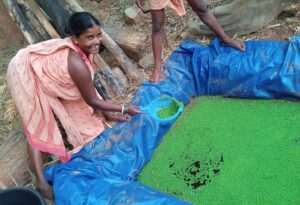Azolla farming offers new lease of life to ekari farmers
In the remote village of Ekari, which is also a Gram Panchayat in Kosagumuda Block of Nabarangpur District, you’ll discover small square pits measuring 4×4 or 5×5 feet in most households. These pits are covered with green nets to protect them from twigs, dried leaves, and mosquitoes. Upon closer inspection, you’ll find that these pits are used for cultivating Azolla, a type of feed for livestock, especially cattle and goats. But why is Azolla cultivation important?
Despite being the Gram Panchayat, this village is quite remote, and most residents rely on agriculture for their daily income. Similar to many other villages, the farmers in Ekari are limited to cultivating a single crop annually due to a lack of proper irrigation facilities. During the non-farming season, the women in these households make a living by collecting NTFP (Cashew nuts), but this couldn’t provide a substantial income.
To assist these villagers in achieving a stable income, CYSD, in collaboration with ITDA and the Veterinary Department, has supplied chickens and goats to several beneficiaries. Specifically, 55 families have received 25 chickens each. Additionally, 2 self-help groups (SHGs) have been given 32 goats each (30 Nos. female and 2 Nos. male) to establish goat farms. This support has enabled the beneficiaries to secure a steady livelihood. Dhanamati Majhi, a 29-year-old beneficiary who received chicken, mentioned, “Each chicken can lay approximately 40 eggs per year, and each egg is sold for ₹6/-. In case of emergencies, each chicken can be sold for ₹300/-.”
Moreover, to assist these people in generating more income with minimal investment, 25 families have been identified and introduced to Azolla cultivation. How can this plant contribute to cost reduction and increased revenue? Well, one of the significant expenses in livestock rearing is fodder for the animals, which can be a cost addition to these families.
 With assistance from the Veterinary Department, these 25 families have received Azolla saplings along with Rs. 1,500/- for each family to establish an Azolla pit. The process involves filling the pit with water and allowing the saplings to grow for 15 days. Once Azolla is fully grown, a portion remains in the water while the rest is mixed into the fodder for cattle and goats. This not only reduces the cost of buying livestock feed but also fosters community building and interdependency.
With assistance from the Veterinary Department, these 25 families have received Azolla saplings along with Rs. 1,500/- for each family to establish an Azolla pit. The process involves filling the pit with water and allowing the saplings to grow for 15 days. Once Azolla is fully grown, a portion remains in the water while the rest is mixed into the fodder for cattle and goats. This not only reduces the cost of buying livestock feed but also fosters community building and interdependency.
In the near future, there are plans to generate revenue from Azolla. As the poultry and goat farms in the village are growing, the demand for Azolla is also on the rise. Therefore, villagers believe there is a promising opportunity to generate income by selling Azolla to fellow villagers whenever required.
